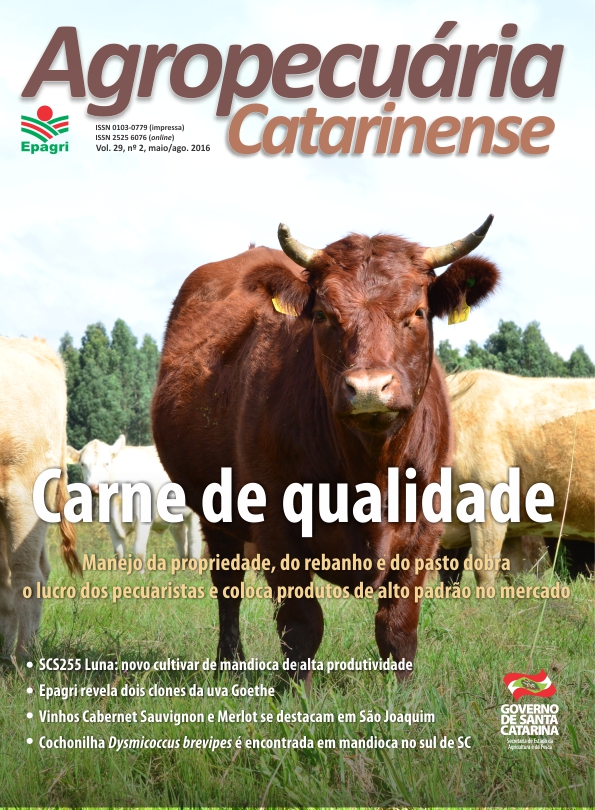Estimation of the flowering-harvest period duration in varieties of peach in Urussanga, SC
DOI:
https://doi.org/10.52945/rac.v29i2.71Keywords:
Prunus persica, phenology, temperature, fruit development.Abstract
Abstract: This study aimed to develop regression models to predict the duration of the flowering-harvest phase in Urussanga, Santa Catarina. The number of days between flowering and harvest is important for assisting in making decisions about time and intensity of thinning. Correlations were evaluated between the duration of the phase, the date of full bloom and the daily average temperatures accumulated after that date. The date of full bloom showed to be the most important variable for the estimates. Regarding the variable temperature, the average of the first 70 days after full bloom for the short and medium cycle varieties, and the average of the first 100 days for long-cycle crops were those that had the highest correlations. As a result, this study indicated that other factors related to the full bloom date, in addition to temperature that occurs after blooming, can influence the duration of the flowering-harvest phase.Metrics
References
BONORA, E.; STEFANELLI, D.; COSTA, G. Nectarine fruit ripening and quality assessed using the index of absorbance difference. International Journal of Agronomy, v. 2013, p.1-8, 2013.
CONEVA, E.D.; CLINE, J. Blossom thinners reduce crop load and increase fruit size and quality of peaches. HortScience, v.41, p.1596-1601, 2006.
DAY, K.; LOPEZ, G.; DEJONG, T.M. Using growing degree hours accumulated thirty days after bloom to predict peach and nectarine harvest date. Acta Horticulturae, v.803, p.163-166, 2008.
DELA BRUNA, E. Curva de crescimento de frutos de pêssego em regiões subtropicais. Revista Brasileira de Fruticultura, v.29, p.685-689, 2007.
FARRAR, D.; GLAUBER, R.R. Multicollinearity in regression analysis: the problem revisited. Review of Economics and Statistics, v.49, p.92-107, 1967.
LOPEZ, G.; DEJONG, T.M. Spring temperatures have a major effect on early stages of peach fruit growth. Journal of Horticultural Science and Biotechnology, v.82, p.507-512, 2007.
LOPEZ, G.; DEJONG, T.M. Using growing degree hours accumulated thirty days after bloom to help growers predict difficult fruit sizing years. Acta Horticulturae, v.803, p.175-180, 2008.
MARRA, F.P.; INGLESE, P.; DEJONG, T.M.; JOHNSON, R.S. Thermal time requirement and harvest time forecast for peach cultivars with different fruit development periods. Acta Horticulturae, v.592, p.523-529, 2002.
MURAO, S.; FUKUDA, T.; MARUO, Y. Prediction of cropping optimum period of peach [Prunus persica] “Akatsuki” by average temperature and duration of bright sunshine. Bulletin of the Kagawa Prefecture Agricultural Experiment Station, v.55, p.33-36, 2002.
NAVA, G.A.; MARODIN, G.A.B.; SANTOS, R.P. Reprodução do pessegueiro: efeito genético, ambiental e de manejo das plantas. Revista Brasileira de Fruticultura, v.31, p.1218-1233, 2009.
PETRI, J.L.; LEITE, G.B. Consequences of insufficient winter chilling on apple tree bud-break. Acta Horticulturae, v.662, p.53-60, 2004.
SOUZA, A.P.; LEONEL, S.; SILVA, A.C. Basal temperature and thermal sum in phenological phases of nectarine and peach cultivars. Pesquisa Agropecuária Brasileira, v.46, p.1588-1596, 2011.
TOMBESI, S.; SCALIA, R.; CONNELLl J.; LAMPINEN, B.; DEJONG, T.M. Fruit development in almond is influenced by early spring temperatures in California. The Journal of Horticultural Science and Biotechnology, v.85, p.317-322, 2010.
Downloads
Published
How to Cite
Issue
Section
License
Copyright (c) 2016 Revista Agropecuária Catarinense

This work is licensed under a Creative Commons Attribution 4.0 International License.



